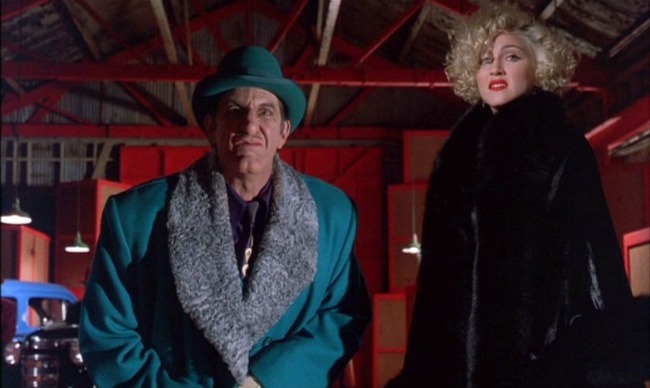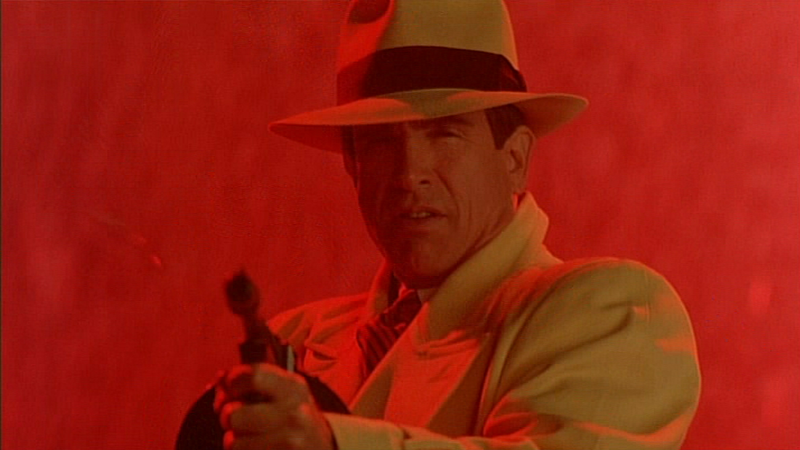When people talk about the iconic comic book movies that helped jumpstart this industry and culture devouring trend, they mention Tim Burton’s Batman, the first X-Men movie, Spider-Man, or Richard Donner’s Superman. They don’t usually mention Warren Beatty’s Dick Tracy, a film with a cornball story, a star-studded cast, and an impressively daring sense of visual style.
It’s been 25 years since Beatty brought his vision to the screen and despite the years, the film still holds up and it still effectively makes its case for “classic” status. Here are a few reasons why you should see it for the first time, give it a re-watch, and/or hold it in higher esteem.
Tone
If Batman ’66 and Burton’s Batman had a baby, and that baby was raised by Frank Miller’s The Spirit and occasionally visited by Sin City for ballgames and its first beer, the result might be Dick Tracy. Let me be clear, this wasn’t a toy commercial or a kid’s film even though it was thoroughly merchandised and colorful in a cartoonish way. It’s not dark and gritty either. Accessible to all ages without pandering, Beatty’s film is as much a love letter to the original Chester Gould comic strip as it is to 1930s pro-crime stopper films like the James Cagney-starring G Men and the Edward G. Robinson-starring I Am The Law. The dialogue is mob movie 101 with a few “dames” and “kids” mixed in with paperback noir-speak like the above exchange between Tracy and Madonna’s Breathless Mahoney.
Madonna, of course, had a hand in the film’s musical tone as well, but Stephen Sondheim deserves the bulk of the credit. At times, the score echoes that of Batman, and I’m sure that wasn’t accidental, but the use of the Sondheim-penned musical montages (including the Oscar-winning “Sooner Or Later”) to illustrate both Tracy’s run of informed good luck against the criminal underworld and the reverse of that later on is thoroughly unique and adds to the fun feel of the film.
The Cast

Shampoo is the finest example of Warren Beatty’s magnetism, but while his charm ray is lowered a little when he plays the above reproach lawman who is desperately trying to deny the heat between he and Breathless Mahoney and hold onto his relationship with the constantly put-upon Glenne Headly, it’s still evident. As Mahoney, Madonna is all sex-pot while Headly alludes to a layer beyond her nice-girl exterior when she threatens to break the kid’s arm after he swipes a five and when she plays coy with Tracy as he’s trying to propose.
The villains are the real highlight of the cast, though. With the exception of Dick Van Dyke (who traded on his familiar face to throw a curve ball) and James Caan, the rest of the Rogues got to be all decked out in their silly suits and hidden with makeup. Beatty could have cast a bunch of no-names, but instead he hit his Rolodex hard and brought in a group of well-known character actors (William Forsythe, Seymour Cassel, and Paul Sorvino) and stars (Caan and Dustin Hoffman) to play the baddies and flunkees that surrounded Al Pacino as the main big bad, Big Boy.
The “top” looks like an ant from where Pacino stands in this film, that’s how “over” it he is as the power-mad gangster/dance choreographer and scenery chewer, but it works within the context of this film even though the performance — which got Pacino a Best Supporting Actor nomination — is quite possibly the most cartoonish comic book villain this side of John Leguizamo in Spawn.
The Look
Dick Tracy actually received seven Oscar nominations, winning three. Two of those three went to Richard Sylbert and Rick Simpson for Best Art/Set Direction and to John Caglione Jr. and Doug Drexler for Makeup, and they are well deserved.
Moving the world of Dick Tracy from comic strip to live-action required a careful but imaginative application of makeup effects to turn those monstrous and deformed Rogues into villains that stood out, but didn’t make the film feel like a creature feature. Sometimes, those transformations were slightly subtle, as with Forsythe’s Flattop and Sorvino’s Lips, but others were a bit more exaggerated, like Little Face.
As for the visual effects, it’s simply the most striking thing about the film 25 years later, and something that people maybe didn’t have the chance to fully appreciate at the time. But with Frank Miller and Robert Rodriguez’s Sin City films and Miller’s The Spirit, it’s abundantly clear how ahead of his time Beatty was with the look of this film and its city, which feels as though it is half cartoon and half real life thanks to the use of matte paintings and bold colors.
This entire film could have taken Tracy off the page and shoehorned him into a world more like our own. Taken him out of his time too, but Beatty had a literal interpretation of the term “comic book movie” and that meant that Dick Tracy looked like a spectacle with an exaggerated skyline, cheesy dialogue, a loud visual sense, and meaty shots of our hero busting bad guys. No subtlety, no apologies for what it is, no grittiness, and certainly no neo-realism. And while audiences are far more interested in seeing comic heroes go on adventures within worlds that mirror our own, we should all tip our yellow fedoras to a film that was willing to challenge our imaginations and invite us into its bold world.







